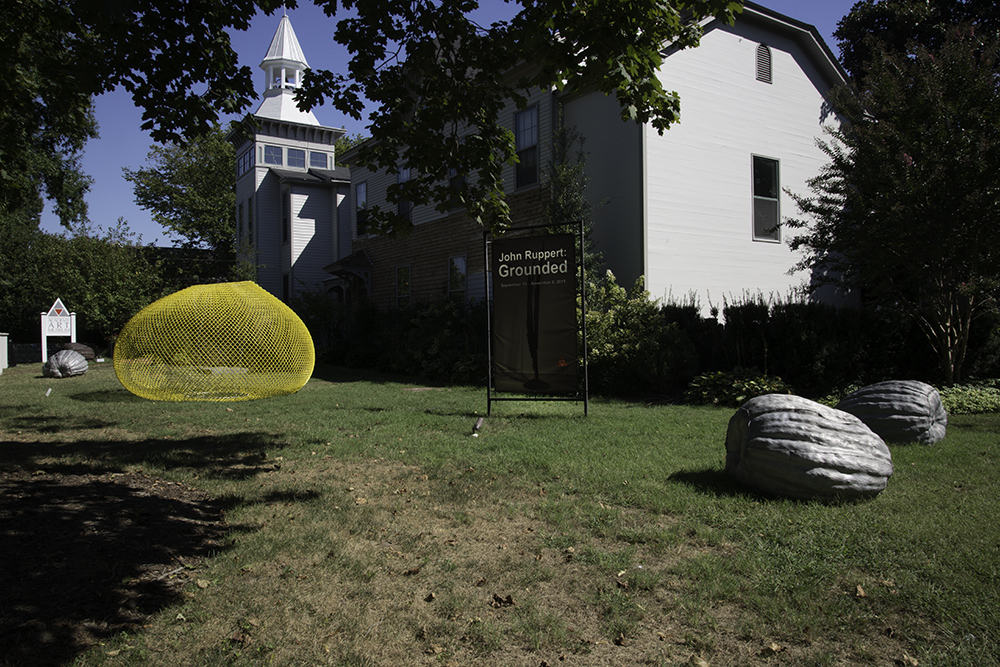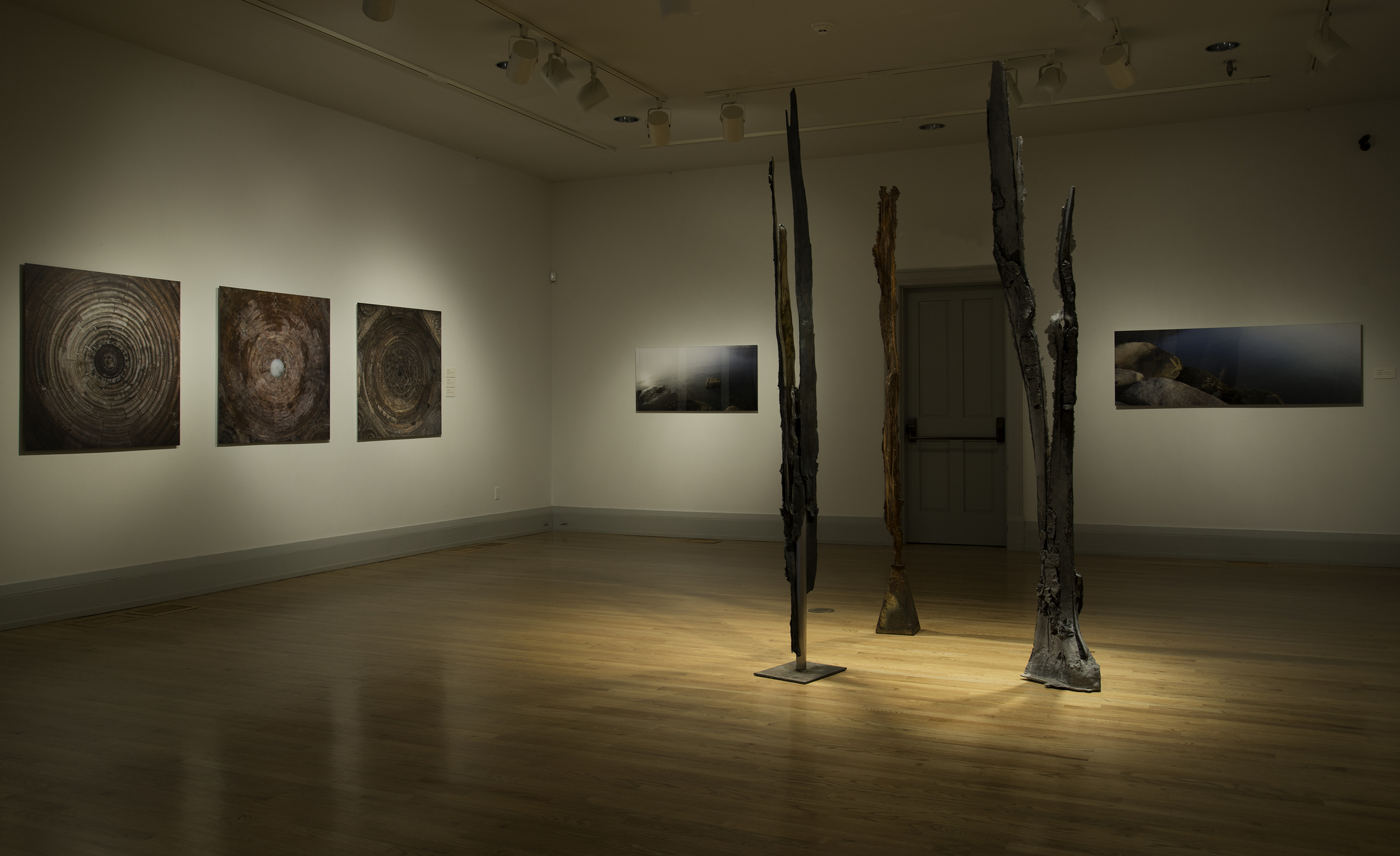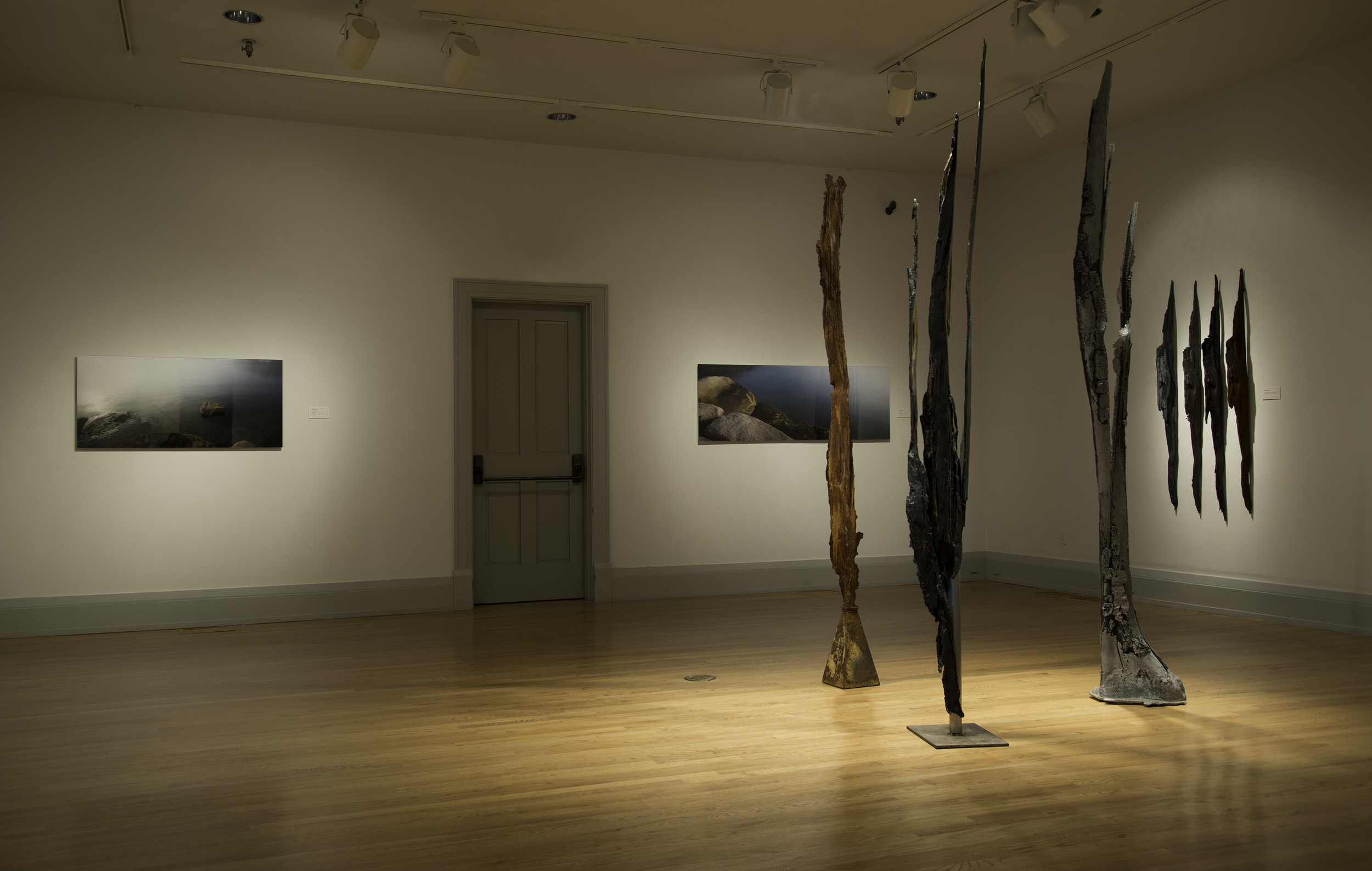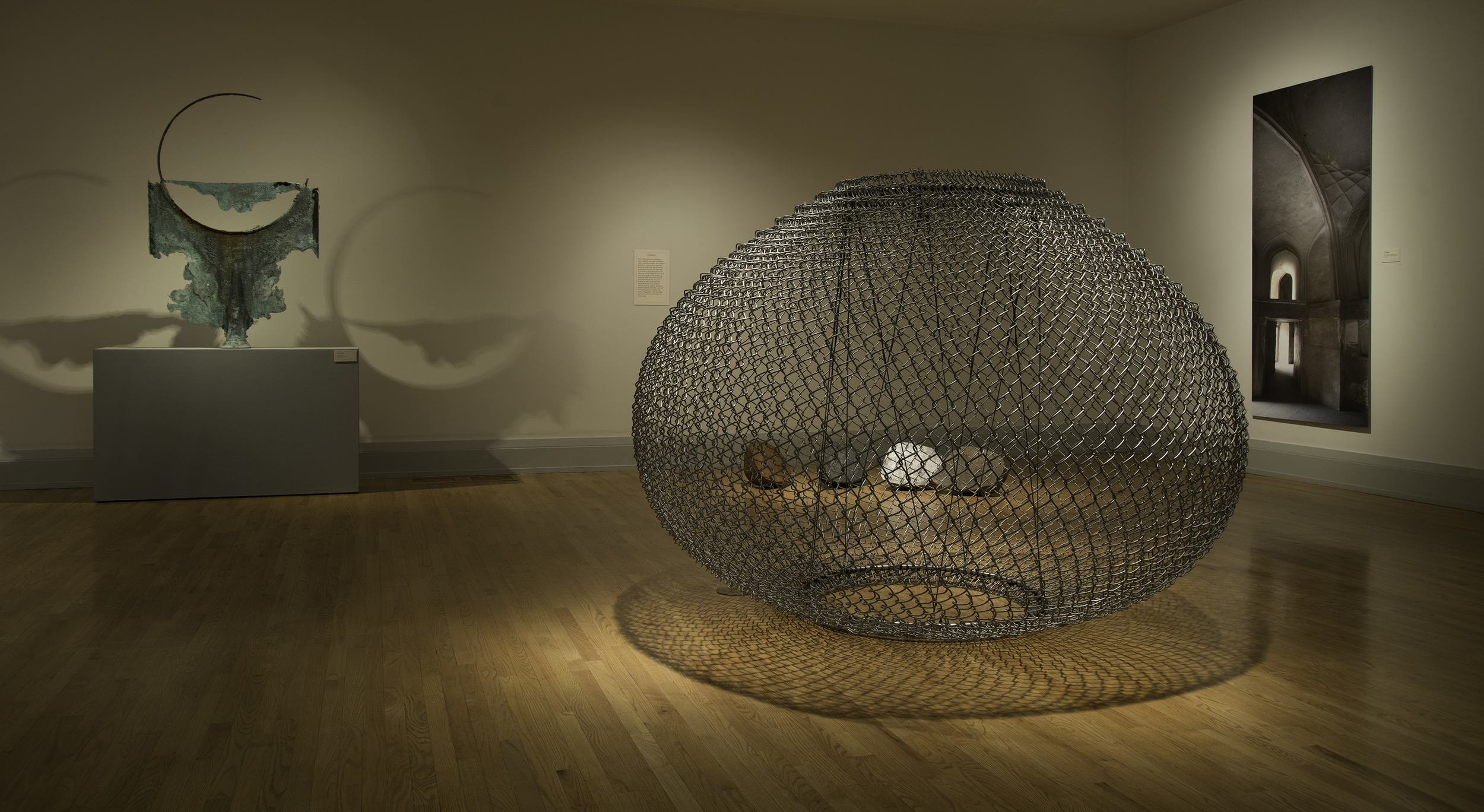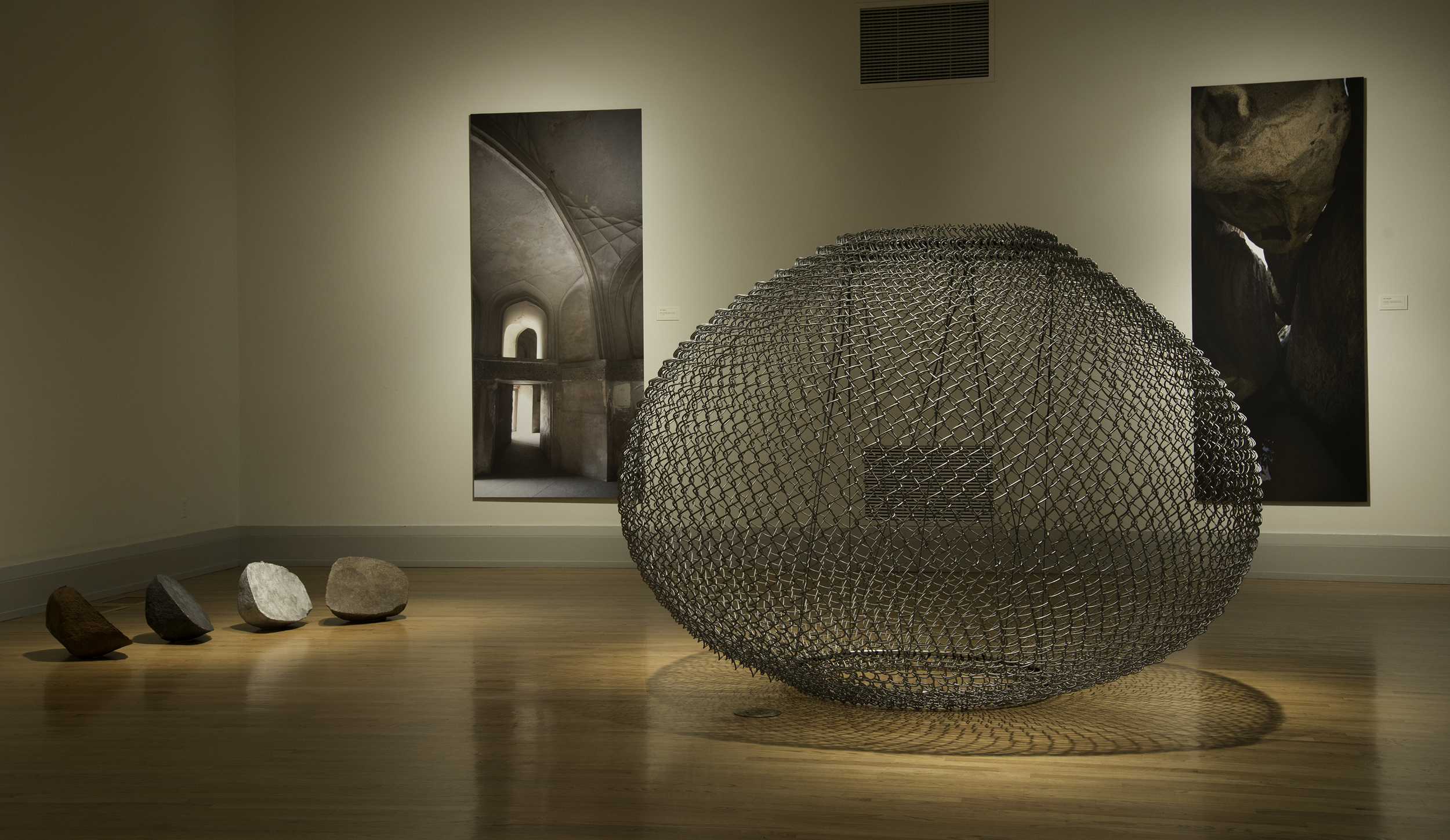‘EMPIRICAL EVIDENCE’ OF CATACLYSMIC CLIMATE CHANGE
ELAINE FISHER FEBRUARY 20, 2019
Installation view of LAB: Empirical Evidence
John Ruppert’s LAB: Empirical Evidence at UMBC examines our relationship to climate change in physical and psychological ways
Last June, Hawaii’s National Park Service reported that the parking lot providing access to the Halemaʻumaʻu crater at the summit of Kīlauea had fallen in.
Reports like this have the capacity to shock us into inaction: What can we do against such extreme forces of nature? Framed by footage of the Kīlauea volcano and the crashing retreat of glaciers, John Ruppert’s LAB: Empirical Evidence, at UMBC’s Center for Art, Design and Visual Culture, presents a series of installations that cut through climate change’s sublime imagery to help us accept what we have already done—and what we must do before the road literally runs out.
A walk-through Empirical Evidence offers a kind of coming-to-consciousness, a psychological journey through the wound of climate change, in which Ruppert repositions the visitor from voyeur, to entangled culprit, to reflective conscience, to holder of the creative solution. Like a psychological cure, Ruppert’s work suggests we can find an approach within the wound itself, wielding our ability to interact with nature and master its natural resources towards a solution.
The exhibition space is awkward: part ceiling-tiled office, part walled cavern into which the work barely fits, and the wooden floor and cable covers just keep getting in the way. This makes the work difficult to photograph but serves as a reminder that it’s the experience that counts here, not our aesthetic judgment. Our understanding of climate change should not be aesthetically pleasing or otherwise made palatable or comfortable. Ruppert’s exhibition is cleverly designed around this concept, with objects as obstacles placed in front of alluring, dramatic video works of nature at her most spectacular.
The uncomfortable entrance to the gallery is cleverly co-opted as a visitors’ center—like what you might see if you were able to get close to some of these natural sites were they not under such cataclysmic change—complete with scenic photographs, corporate statement, and viewing window. The photographic landscapes paint a global picture from Iceland to Italy and home to Hawaii and Maine. In many of the images, nature has been manipulated—a colored ground replaces the sky, drawing our attention to various aspects of the image: nature and artwork, seen and unseen, before and after. The color acts as a kind of shadow, a man-made cloud looming above, anticipating what’s coming.
Bittersweet Vines and Calving Ice in LAB: Emperical Evidence
Encountered first in the visitors’ center and winding throughout the exhibition, the trailing limbs of “Bittersweet Vines” bring nature into the gallery and entangle the visitor into its experience. Concrete boards, part of Ruppert’s “Water Threshold,” delineate the edge of the visitors’ center and here, on the boundary between introduction and experience, is the first hint of the sensory undertaking that is to come. As the sound from “Water Threshold” rushes in towards me from the other side of the wall, crashing into the visitor’s center, I wonder how long it will be before this place also slips into the abyss.
Crossing the threshold, a sublime, silent video work titled “Calving Ice” projects onto the gallery wall, showing the retreat of multiple glaciers. The projection, like the event it depicts, is immense, reaching to the top of the gallery wall and across much of its length. The invasive vine, equally vast in its reach so as to dwarf my presence, repeatedly trails up and down in front of the projection, casting its shadow onto the scene. It is impossible to separate static vine from moving image, to get a clear view. Realizing I am not here as a neutral witness but caught up in this story, I view the ice-surf coming towards me and note the vine is alarmingly unmoved.
Celestial Event Series created with various types of magnets and volcanic sands, the sands harvested
from sites including the Adirondack Mountains and Joshua Tree.
I am distracted by a boom, a crashing sound over to my left where two boulders stand face to face. The sound makes me think of the Lawry’s Island Quarry, one of the sites of the photographs from the visitors’ center. But questions of trust and reality soon start to emerge, as I discover that only one of the boulders in the “Maryland Boulder/Echo Rock Series” is real; the other is an exact replica, forged in iron. Evoking the players of climate change, the academics, and the political rhetoricians, Ruppert opens up the gap between what we see, what we are told, and what we experience for ourselves. The two boulders appear to stand in opposition, perhaps considering the impact of a volcanic eruption one of them has experienced, connected as it is to a computer monitor recording live seismic events throughout the world.
The cast-iron wedges of “Liquid Tectonics,” described by the artist as a “zipper,” are perhaps an attempt to close this gap between real and forged, fact and fiction, preventing confusion from opening up a void of despair. Arranged in a crater-like circle, in front of a video projection of what appears to be a raging fire, the iron wedges—manmade forms harnessing gravity to slump towards the earth—evoke futile attempts to shore up the walls of a growing chasm. Each cast form lands differently, spreading out of control like lava from a volcano, liquidly chasing something just beyond reach. What force holds these forms together is unknown. It seems at any point the plates might separate, dropping us into a vortex below. In the ambiguously titled “Kilauea, Ocean Entry ‘Fire Hose’ Lava Flow,” we could be watching molten lava or the artist’s iron-working facility. The video frame is static, close up to the fire, engulfing any detail that might give us a clue—but either way the fire is manmade. In the raging fire that has created or metaphorically consumed “Liquid Tectonics,” humans have played a part.
I perch on a bench that appears to be provided specifically for me to contemplate my role within this unfolding drama. There is sound above me but I can’t quite make it out. I am more attuned to the dramatic seismic activity—this new sound is mundane. But as I sit I start to hear traffic, cars on the road. The speaker for “On the Edge” is set into a glass pendant lamp hanging over my head, directing its sound into my brain, forcing me to think about the impact my daily routine has on the planet. The re-emergence of “Bittersweet Vines” in this space suggests that this seed-thought will need to become as prevalent and unrelenting as the vine if I am to make any difference at all.
John Ruppert’s Omphalos
Just beyond the vine, in my line of sight, is what could be a beacon of hope. “Omphalos,” a religious stone symbolizing the center or hub of something, is a brilliant white form cast in salt and graphite, a seemingly misplaced, upside-down, conical vase that stands on a plinth. To right the vase I would have to reverse it, find a way to balance it. Sitting here, almost at the center of the exhibition, it seems I have reached the nub of the issue. But the relief I feel is cut short by the realization that only a complete U-turn will suffice. We cannot turn back or stop the wheels of time. As if mirroring this thought, the soundtrack that lulled me into this reverie, with its emerging birdsong, is overcome by a vibration in the bench on which I am sitting. Somewhere another tremor in the earth has been recorded. I cannot dismiss it as a tube train passing below. I know too much now and the weight of this knowledge feels impossible to bear.
The final act takes place in an antechamber. It offers a kind of sanctuary if not the directive I am seeking. Turbines driven by geothermic activity are translated into audible frequencies to provide a primordial, echo-like soundtrack to an encounter with three tables holding three pieces, each displaying offerings of volcanic sand gathered around an earth magnet. These objects and the sound piece allude to a partnership with nature, suggesting we already have the skills to stop the destruction of our planet; it is within our reach. We can harness our creative potential, find the right path, and let nature do the rest.
LAB: Empirical Evidence is on display at UMBC’s Center for Art, Design, and Visual Culture through March 16. For more information, visit artscalendar.umbc.edu (https://artscalendar.umbc.edu/).
Photos by Vivian Marie Doering, Tom Moore, and Marlayna Demond, courtesy of UMBC CADVC.






